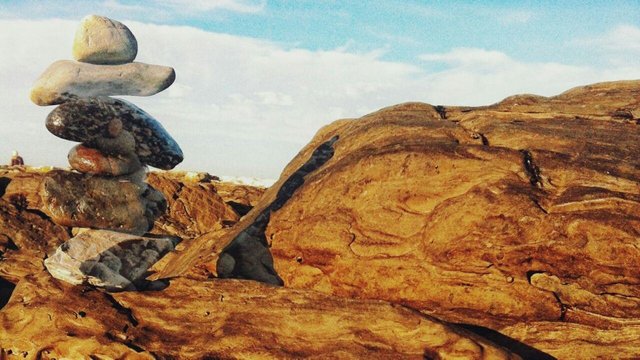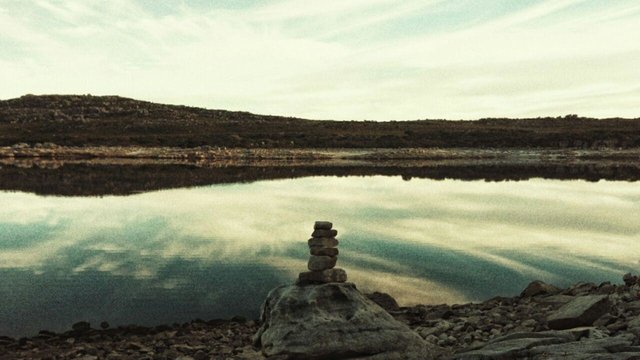Too Much Remembering Leads to Forgetting
One woman's journey of negotiating memory through art-making
ABSTRACT: The following article reflects on the ways people negotiate memory. These reflections are the result of a Practice as Research study which used a performance art project as a starting point. This project is called Too Much Remembering Leads to Forgetting, which was performed over the period of two years in South Africa, Germany, Denmark, Sweden and Peru.
We shall not cease from exploration
And the end of all our exploring
Will be to arrive where we started
And know the place for the first time.
- T.S. Eliot, Little Gidding
Some years ago, a man I loved skipped town in the middle of the night and broke my heart. It nearly broke my mind as well. In an effort to process the weights of loss that comes with any ending, and to transmute the shades of confusion and grief that come particularly with dishonest ones, I took to building cairns. I have, by now, left a trail of cairns upon the landscapes of Earth as well as my mind. This healing, art-making, process was enacted for two years, and grew into a Practice as Research inquiry into the ways humans negotiate the processes of memory and the role of the human body within these processes.

...Practice as Research, or PAR, is a methodology in which art-making is consciously engaged with as a means of research into a phenomenon. For example, in order to understand more about the ways people negotiate memory, I engaged in my own ritual performance praxes as a means to negotiate my relationship with my own memories. These activities were centred on personal negotiations of remembering and forgetting. These experiences were then articulated through the art-making process and product, as well as through the language of theory. As a researcher, working with Practice as Research as my methodology, I engaged with a body of theory simultaneous to my practical exploration. The bodies of theory a PAR researcher works with informs the way their art-making practice is articulated in relation to both itself and the subject, and in turn, the art-making practice, and observations and articulations around it, inform the way the theory is negotiated, and renegotiated. Thus new theory is born through art-making, and new art-making born from theory...
Humans build cairns as markers: a pile of stones to catch the eye of a traveller toward an otherwise overlooked turn in a mountain trail; to pin the presence of a human body in the landscape in a visible way; to mark the site of a burial; and as a burial mound itself. All of these functions were at play in my practice: I marked a trail across the landscape of our memories by leaving real cairns in the places we had inhabited together. Slowly I began to build them wherever I found myself thinking toward him in any significant way: as a way to externalise these internal processes, so that I may move beyond them. The cairns became a mnemonic bridge between my present solitude in that physical place, and the pasts in which we experienced those places together. They allowed a way to acknowledge the overwhelming moments in which I was not alone in my head, yet denied his physical presence. It allowed a way for me to acknowledge him and leave him behind. The process of gathering those stones, and of placing them one atop the other, all held within the passage of time in which this activity occurred, was the alchemy that transmuted the base metals of grief and pining to the gold of forgiveness. Here were the places I buried a part of his memory each time, the places in which I marked my passage through this process, and the places in which I have now started to celebrate in memory. For, as these cairns began as a memorialisation of a loss, they also chart a journey of growth.

Each cairn resulted from movement within the physical and mnemonic landscapes and explored the edges of things: the edges between reality and fiction, and pasts and presences. Through documenting the process, I began to explore how these tensions are negotiated through the dissonance between performance practices and their forms of archiving. For instance, in this case it is the act of building the cairn, not the cairn itself that functions as memorial. The cairn is just residue. But it is the cairn that can be photographed, and therefore legitimised through archival processes. Upon reflection, the two-year cairn-building process illuminates relationships between spaces of Memory, and the two places they are primarily negotiated in: that of the (document) Archive and the (embodied) Repertoire.
Essentially, humans have developed two main ways of keeping track of their pasts. The first way of recording past is through the Repertoire (Taylor, 2003). The Repertoire is a performed body of memory, and an essentially oral and embodied tradition. In its simplest form, it is the stories and ritual choreographies we pass down from one generation to the next, in order to understand who we are and our places in the worlds. Memory, in the Repertoire, is embodied: you carry your narrative of the past in your body, and express it through the choreographies of performance and rituals you know and the stories you have learned and may share in your turn.
The second way humans have come to remember is through the concept of Archive (Derrida, 1996). In the logocentric social hegemony, the Archive is the favoured way of negotiating memory; if something is written down or physicalized in the form of an artefact that exists beyond the human body, it carries a legitimacy denied to the spoken word. Pasts recorded in a document- a book, a picture – are more easily considered fact. These artefacts, stored in the Archive, are drawn on by scholars, historians and other members of our society with the social authorisation, when forming historical narratives. Meanwhile, Repertoire takes on a flexibility that our society with its post-Enlightenment hangover finds difficult to deal with. Storytelling practices, in fact, even encourage that with each retelling you ‘throw some words away’ (Pinkola Estés, 1992) in order to maintain the voracity of the story’s healing and acculturating function. The Repertoire, then, is an internalised, embodied memory practice, and the Archive a static, externalised one.
My journey has led me to the awareness that an understanding of the strengths and weaknesses of both forms of memorialisation praxis, both Archival and Repertoiric forms, are important in order to maximise the potential of our social human body to move forward consciously toward sustainable futures: both with ourselves, and with each other. A repertoire practice, the cairn building, led me to transmute at the level of my heart: my body feels different toward my experiences with this man as a result of this practice. Coming to terms with articulating that practice to myself and others, as well as negotiating its legitimising within society through embracing forms of Archiving, has helped me extrapolate the effects of this repertoiric engagement toward the general human body. Through Archival process, I can map to domains otherwise closed to me. In other words, a body requires both a heart and a head. The heart (Repertoire) is not complete without the head (Archive), and the head cannot function without its heart. They are both two different forms of brain. But neither can function without hands; a form of being in the world centred wholly toward not the past, or future, but the present moment.
That is the learning that has occurred through this project. Through self-observation practice, I came to understand that the act of arriving in a place, the choreographies of collection, movement and (re)placement of stones all left indelible marks upon the landscapes I wished to preserve in memory, which ironically altered their ontological nature. Through my efforts to preserve them, I changed them. And through changing them, I changed. Through an essentialised form of PAR – doing and reflecting upon that doing and then doing some more ad infinitum- I have come to understand that, at the end of it all, Too Much Remembering Leads to Forgetting.

This is the use of memory:
For liberation—not less of love but expanding
Of love beyond desire, and so liberation
From the future as well as the past.
– T.S. Eliot, Little Gidding
References and Selected Bibliography
- Derrida, J. 1998. Archive Fever: A Freudian Impression. Translated by Eric Prenowitz. Chicago: University of Chicago Press
- Eliot, T. S. 1942. Little Gidding. Available Online, 27.06.2017: [ http://www.columbia.edu/itc/history/winter/w3206/edit/tseliotlittlegidding.html ]
- McGillivray, G. (Ed). 2011. Scrapbooks, Snapshots and Memorabilia: Hidden archives of performance. Bern, Switzerland: Peter Lang AG
- Pinkola Estés, C. 1995. Women Who Run With the Wolves: Myths and Stories of the Wild Woman Archetype. New York: Ballantine Books
- Taylor, D. 2003. The Archive and the Repertoire: Performing Cultural Memory in the Americas. USA: Duke University Press
All Images by Katara Sedai, edited by Hanjones
Congratulations @katara.sedai! You have completed some achievement on Steemit and have been rewarded with new badge(s) :
Click on any badge to view your own Board of Honor on SteemitBoard.
For more information about SteemitBoard, click here
If you no longer want to receive notifications, reply to this comment with the word
STOPDownvoting a post can decrease pending rewards and make it less visible. Common reasons:
Submit
cool article
Downvoting a post can decrease pending rewards and make it less visible. Common reasons:
Submit